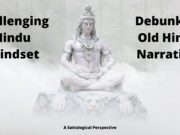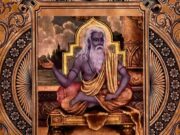Sanatana Dharma encompasses every aspect of human life in all facets. It covers the entire gamut of politics, dharma (law of righteousness), pancharatra (ritual process of worship) , military, social structure (Varnashrama), economics (Artha) and diplomacy which will be the focus of this article of mine. Every Hindu lives in the glory of their prosperous past. If we look at the history of India during the ancient Ramayan era, we will find abundance, morality and military conquests. Coming closer to our age, just 5000 years ago, India was the home to the world’s most powerful and affluent moral elite. Their supremacy on all aspects of human development was shattered slowly over the period of 5000 years with the lowest point being 1947 when their land was divided by two conquering faiths. What went wrong ? Despite having the best knowledge on all aspects of military, economy, science and law, they were still defeated. Their culture enslaved, questioned and repeatedly humiliated during the last 1500 years by those who looted them to become rich.
What happened during these last 1500 years? Have Hindus learnt any lesson so far? What was so different in the quality of their ancestors that they lack today? Many of these questions can be answered if we analyze the histories of Mahabharat & Ramayan.
Take for example, Ramayan (Valmiki) mentions the strength of the city of Ayodhya. Ayodhya was a very large city state approximately 2304 sq miles, absolutely unconquerable by anyone. The rule of Dasharath made it militarily, economically and dharmically strong. The extension of global power of the city state of Ayodhya extended through alliances and treaties with all states west, East, north and south of Ayodhya. Every inch of the city state of Ayodhya was fortified with powerful men and modern weapons. The safety infrastructure of Ayodhya ensured that virtually every affluent businessman could reside in Ayodhya and make their life successful. In the west Ayodhya was protected through alliance with Kaikeya kings. In the north Ayodhya was protected through alliances with kings from Uttarakuru. On the East, Ayodhya was protected through alliances with Malaya kings while on the south, Ayodhya was protected until Janasthan with the blessings of Agastya rishi. These alliances extended the boundary of Ayodhya’s diplomatic power. A state is known by powerful alliances because those alliances create the Defence of the state. The wars have to be fought outside the boundaries of the alliances of the state. That’s what made Ayodhya a very strong and powerful state. Most Hindus are not taught these facts about their history from Ramayan. The strength comes from physical prowess as well as morality.
Shri Ram’s father Dashrath was an expert warrior as well as a moralist as well as a strong follower of Dharma. (Excerpts from my book: One Arrow, One Kill)
Let’s come closer to our ancient past and look at the Kingdom of Hastinapur. Hastinapur made alliances with kingdoms of Gandhar, Malaya, Uttarkuru, Madr, Kaikeya, Abhir, Shaka, Pulandas, Parsik and Khasa (China), through marriage relationships and outright military conquest. India’s economic prosperity 5000 years ago was due to military prowess and also being the home of law, truth and justice. Hastinapur was the ideal capital of this Bharat because it was equidistant from Uttarkuru and Kerala. For those who do not know, the region north of Kyrgyzstan is considered as Uttarkuru which confirms to those geographical definitions in both Valmiki Ramayan as well as Mahabharat. Again the Aryavrat or the land of civilized people (followers of Sanatana Dharma) was defended outside the boundaries of these alliances. It almost makes an arc of 800 miles around Hastinapur to the north and west. However, in the East this distance was measured from the current Indian state of Manipur.
All the initial attacks on India during the last 1500 years have come from the west and in the East through Malaya (Dutch East India company).
Later, the Portuguese came via the Horn of Africa to Gujarat. What changed between Chandragupta Maurya’ victory over Greece to the conquest of Islamic looters on the western borders of Aryavrat? If we analyze the problems and solutions used from Mahabharat, we will also find the solutions for today. But if we reject the structure of alliances of Mahabharat war then we will play into the hands of the invaders. Most military Defence policy of India 🇮🇳 practically follows the British style holding pattern which is not Dharmic at all. Wars are won by superior attacking strategies backed by adequate tools & tactics. The race for technical parity with the west is foolhardy because India has never fought a long sustained war like the western countries have done. During world wars also, India played a supporting role to a large extent. Vietnam defeated the powerful USA and China with their own arsenal which was much inferior. Pandavas defeated the much superior armies of Kauravas through strategy and tactics with their own weapons. The rule of Yudhishthir was successful because they maintained a military pressure on their enemies in the enemy territories.
Technologies have changed and also the war tools may have changed but the strategy of warfare whether be guerilla, formations and tactics haven’t changed. In many cases the predictability of the efficacy of colonial armies is a publicly known feature.
The powerful diplomacy will work only when there is an ambiguity of military power. Read: Yudhishthir, the greatest Samrat.
If we analyze the incident of Jayadrath in Mahabharat, Arjun made a suicidal vow for which he was heavily criticized by Krishna Himself. Military tactics and objectives are never disclosed otherwise the enemy makes provisions for defending those.
Similarly, conquered territories are never returned back, instead, people in those territories are trained to follow Sanatana dharma.
Indian leadership post-independence has been the prisoner of colonial thought process because of which India never became independent until now.
Even today the same mindset is continuing barring the exception in that at least the political leadership is closer to Dharma than before. But the bureaucracy is still carrying the legacy of colonizers. Most Indian planners are not even aware of the greatness of their civilization and even the war fighting, spy craft and other diplomatic strategies from ancient Vedic shastras. One basic piece of advice, never assure your enemies of proactive non-aggression. It takes the teeth out of diplomacy. Diplomacy only works when there is a credible military threat when objectives are not met. That’s why Yudhishthir never assured Duryodhan of non-attack. But the Hindu or Indian strategic planners repeatedly make the mistake of assuring Indian neighbors of the peace loving nature of Indian civilization. Most natives of the world who were colonized were all peace loving people. What happened to them? They were all mercilessly massacred by the invaders. Read : Gold, Glory & God – A Curse on natives.
If India doesn’t change its military outlook and starts defending itself at least 800 miles away from Indian boundaries, India will again become slave of the global corporations who will work through the border states to occupy India.
The world can be peaceful only with Sanatana Dharma and the goal of Indian diplomacy & Military strategy should be to export Sanatana Dharma in every part of the world through overt and covert means. The global community is waiting for it badly ! It will again be the Sanatana dharma which will come to the rescue of the world, of that there is no doubt.
Just like Hanuman had to be told of his prowess, India is again being reminded of its real place in the world.
Jai Jagannath ! Please donate to support our non-profit.















